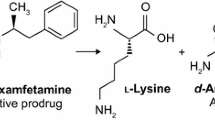Abstract
Orocecal transit time was determined by the lactulose hydrogen breath test in nine healthy volunteers after administration of placebo, loperamide (16 mgper os), and loperamide (16 mgper os) followed by oral naloxone at doses of 16 and 32 mg. The four tests were performed in double-blind conditions and in random sequences. Transit time (mean,sd) after loperamide (128.8 min, 32.9) was significantly increased (P<0.05) compared with placebo (85.5 min, 35.7), loperamide followed by naloxone 16 mg (88.8 min, 46.2), and loperamide followed by naloxone 32 mg (84.4 min, 40.6). These results show that the peripheral opioid agonist loperamide delays orocecal transit in healthy subjects and that naloxoneper os at adequate doses antagonizes this effect.
Similar content being viewed by others
References
Jaffe JH, Martin WR: Opioid analgesics and antagonists.In The Pharmacological Basis of Therapeutics. Goodman Gilman A, Goodman LS, Gilman A (eds). New York, Macmillan, 1980, pp 494–534
Basilisco G, Bozzani A, Camboni G, Recchia M, Quatrini M, Conte D, Penagini R, Bianchi PA: Effect of loperamide and naloxone on mouth-to-caecum transit time evaluated by lactulose hydrogen breath test. Gut 26:700–703, 1985
Fishman J, Roffwarg H, Hellman H: Disposition of naloxone-7,8-3H in normal and narcotic-dependent men. J. Pharmacol Exp Ther 187:575–580, 1973
Nutt JG, Jasinski DR: Methadone-naloxone mixtures for use in methadone maintenance programs. I. An evaluation in man of their pharmacological feasibility. II. Demonstration of acute physical dependence. Clin Pharmacol Ther 15:156–166, 1974
Zaks A, Jones T, Fink M, Freedman AM: Naloxone treatment of opiate dependence. JAMA 215:2108–2110, 1971
Bromm B, Meier W, Scharein E: Antagonism between tilidine and naloxone on cerebral potentials and pain ratings in man. Eur J Pharmacol 87:431–439, 1983
Metz G, Gassul MA, Leeds AR, Blendis LM, Jenkis DJA: A simple method of measuring breath hydrogen in carbohydrate malbsorption by end-expiratory sampling. Clin Sci Mol Med 50:237–240, 1976
Zuccato E, Andreoletti M, Bozzani A, Marcucci F, Velio P, Bianchi P, Mussini E: Respiratory excretion of hydrogen and methane in Italian subjects after ingestion of lactose and milk. Eur J Clin Invest 13:261–266, 1983
Bond JH, Levitt MD: Investigation of small bowel transit time in man utilizing pulmonary hydrogen (H2) measurements. J Lab Clin Med 85:546–555, 1975
Shafer RB, Prentiss RA, Bond JH: Gastrointestinal transit in thyroid disease. Gastroenterology 86:852–855, 1984
Read NW, Al-Janabi MN, Bates TE, Holgate AM, Cann PA, Kinsman RI, McFarlane A, Brown C: Interpretation of the breath hydrogen profile obtained after ingesting a solid meal containing unabsorbable carbohydrate. Gut 26:834–842, 1985
Ooms LAA, Degryse AD, Janssen PAJ: Mechanism of action of loperamide. Scand J Gastroenterol 19:145–158, 1984
Wald A, Van Thiel DH, Hoechstetter L, Gavaler JS, Egler KM, Verma R, Scott L, Lester R: Gastrointestinal transit: The effect of the menstrual cycle. Gastroenterology 80:1497–1500, 1981
Kirk RE: Experimental Design: Procedures for the Behavioral Sciences. Belmont, California, Brooks/Cole Publishing, 1968, pp 245–318
LaBrooy SJ, Male PJ, Beavis AK, Misiewicz JJ: Assessment of the reproducibility of the lactulose H2 breath test as a measure of mouth-to-caecum transit time. Gut 24:893–896, 1983
Corbett CL, Thomas S, Read NW, Hobson N, Bergman I, Holdsworth CD: Electrochemical detector for breath hydrogen determination: Measurement of small-bowel transit time in normal subjects and patients with the irritable bowel syndrome. Gut 22:836–840, 1981
Van Wyk N, Sommers K, Steyn AGW: Evaluation of gastrointestinal motility using the hydrogen breath test. Br J Clin Pharmacol 20:479–481, 1985
Cann PA, Read NW, Holdsworth CD, Barends D: Role of loperamide and placebo in management of irritable bowel syndrome (IBS). Dig Dis Sci 29:239–247, 1984
Morley JE, Levine AS, Yamada T, Gebhard RL, Prigge WF, Shafer RB, Goetz FC, Silvis FE: Effect of exorphins on gastroentestinal function, hormonal release and appetite. Gastroenterology 84:1517–1523, 1983
Kreek MJ, Hahn EP, Schaefer RA, Fishman J: Naloxone, a specific opioid antagonist, reverses chronic idiopathic constipation. Lancet 1:261–262, 1983
Kreek MJ, Paris P, Bartol MA, Mueller D: Effects of short-term oral administration of the specific opioid antagonist naloxone on fecal evacuation in geriatric patients. Gastroenterology 86:1144, 1984
Schang IC, Devroede G, Perreault R: Naloxone therapy in small intestinal pseudoobstruction. Preliminary results about two cases. Am J Gastroenterol 79:828, 1984
Author information
Authors and Affiliations
Rights and permissions
About this article
Cite this article
Basilisco, G., Camboni, G., Bozzani, A. et al. Oral naloxone antagonizes loperamide-induced delay of orocecal transit. Digest Dis Sci 32, 829–832 (1987). https://doi.org/10.1007/BF01296704
Received:
Revised:
Accepted:
Issue Date:
DOI: https://doi.org/10.1007/BF01296704




